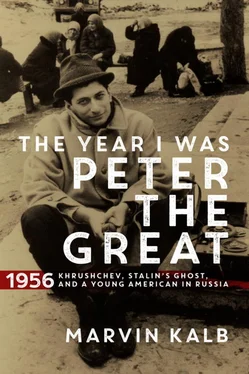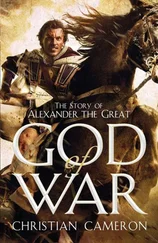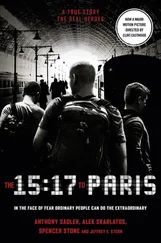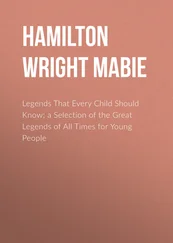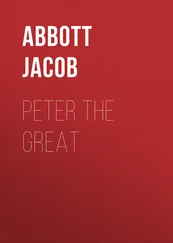That night I wrote in my diary: “The Russians are their own greatest admirers, and they love even the ‘bad boys’ of Russian intellectual life, like Prince Kropotkin. Therefore, they read and worship not only the Lenins, but also the Turgenevs, the Herzens, the Belinskys, and the Kropotkins…. In the Russian political tradition, there have been at least two powerful currents. One is communism, or the extremist sentiment that led to it…. The other is the humanitarian liberalism [of those] who placed the cause of individual freedom above all others.”
This contest between liberal democracy and communist totalitarianism continued through the intellectual upheavals of the nineteenth century and into the twentieth century—indeed, for a time, even after the Russian Revolution. The communists operated on the assumption that they would be the ultimate winners, and for a time they were. They believed history was on their side. But in 1956, the “year of the thaw,” as it came to be called, I stumbled upon a Russia in kaleidoscopic change. Russians knew where they had been—the wars, the purges, the fear, the collectivization of agriculture, the communization of their lives—but they did not know where they were going. Most Russians waited for their leader, their vozhd —a person of awesome, frightening power—to point the way.
Among the elite, even among the communist elite, one sensed impending change, as if the ground under the Soviet regime was beginning to rumble with uncertainty, doubt, and questions: Was communism, as the governing philosophy of the Soviet Union, losing its way? Was the Soviet regime itself so ragged, corrupt, and inefficient that it was demanding reform, and were Soviet leaders not listening? A question seemed to surface in random conversation: Was it now possible that communism was heading toward a historic collapse, or might it stumble along for another few decades, meeting increasingly meaningless industrial quotas, swearing loyalty to a political faith fewer found relevant to their everyday lives, flexing Cold War muscles while at the same time swearing allegiance to “peaceful coexistence”? No one knew the answers.
This was a problem of enormous importance for Russia and for the rest of the world. With my pursuit of the nineteenth-century minister of education and with my job at the JPRS, I was able to observe “the year of the thaw,” or, as I later realized, the beginning of the end of Soviet communist rule as it had been practiced for decades. Armed with nothing more than a burning curiosity about what made Russia tick, I read the usually dull Soviet press, occasionally coming upon a small gem of insight into the functioning of a closed dictatorship. I traveled from one end of this vast country to the other; whenever possible I listened to what the Russian people were saying in parks, libraries, trains, or busy marketplaces. And because I worked under the auspices of the U.S. embassy, I had occasion to meet a number of Soviet leaders, including the ebullient, unforgettable first secretary of the Communist Party of the Soviet Union, Nikita Khrushchev.
CHAPTER SIX
De-Stalinization = Destabilization
It was the sort of clue Anna Holdcroft could spot before her morning tea.
The dictator Joseph Stalin had died on March 5, 1953. Nine months later, on the seventy-fourth anniversary of his birth (and on the seventy-fifth, the following year), the official Soviet press was predictably stuffed with tributes to his genius, his brilliant leadership during World War II, his awesome contributions to the worldwide communist movement. But then, suddenly, on the seventy-sixth anniversary of his birth, in December 1955, just a few months before the 20th Congress of the Soviet Communist Party, Pravda , the official party newspaper and mouthpiece, barely mentioned his name or birthday.
Mistake? Hardly, concluded Holdcroft.
Pravda would not have decided on its own to ignore the great man’s birthday. She knew, from instinct and experience, that the missed opportunity for another round of Stalin-soaked adulation was deliberate. A major political upheaval of some sort was on the near horizon.
When I arrived for work at the JPRS in early February 1956, the place was aflutter with excitement. What was going to happen? The phrase “collective leadership” had begun to appear more frequently in authoritative editorials. Why stress “collective,” Holdcroft asked, if it was not to suggest that the Party had become obsessed with something at the other end of the political spectrum—a “cult of personality,” or a “cult of the individual,” a phrase that was soon to become shorthand for Stalin’s maniacal rule.
It was, I thought, revealing that everyone at the JPRS, using nothing more lethal than the tools of Kremlinology, in this case simply reading and analyzing the Soviet press, could spot the missing adulation of Stalin and then the two politically charged phrases and conclude, ipso facto, that the unimaginable in Soviet life and politics—an attack on the almighty Stalin himself—was in fact imaginable. There it was, emerging for all to see, in the pages of Pravda .
Reading Pravda in Soviet times was an adventure into the unknown. Let’s say that four paragraphs into an unenlightening editorial about Soviet agriculture you came upon the word odnako , Russian for “however” or “but.” The word was a signal that some sort of criticism of established policy was about to follow; and indeed most of the time odnako did lead to criticism. Words were considered literary weapons, used in a class or proletarian struggle against “the last vestiges of capitalism.”
What a time to be in Moscow, what a sobering moment in the Cold War, at least for me and others absorbed with the shifting mysteries of Soviet politics!
At the JPRS, our tea breaks in Kropotkin’s home often sounded like university seminars, Holdcroft holding forth as the judicious mentor and we translators as graduate students bursting with questions.
Is Russia plunging into another power struggle?
Will heads roll?
Could Khrushchev be building his own personality cult while criticizing Stalin’s?
Most important, was Stalinism dying, and, if so, what would replace it?
Yet while we at the JPRS were absorbed with Kremlin politics, ordinary Russians, it seemed, were generally indifferent to politics. One day soon after my arrival I met a forty-year-old Russian, a television engineer by profession. He told me he earned the equivalent of $650 per month, meaning he was a member of the new, rising middle class, no different in his outlook than millions of others who were beginning to enjoy the fruits of modern industrialization. His wife, he said proudly, “loves just being a housewife.” I tried to get him to talk about politics. “No, no,” he said, waving me off. “Politics is for them.” He pointed toward the Kremlin.
The next evening, after a diplomatic dinner at which the dismissal of a top Soviet official was topic number one, I flagged a taxi for the ride back to American House. The driver told me that he worked in a cement factory during the day and drove a taxi at night to supplement his income. I wondered if he had even heard of the dismissal. “Not my business,” he said, with a firm wave of his hand. “That’s the government’s business, not mine.” In Russia, it was safer to be ignorant or to feign ignorance.
I could not escape the impression, even after so brief a time in Moscow, that the city seemed to be divided into two worlds, as I noted in my diary. One was the party, which dominated everything; the other was the people, who felt little connection to the party. “There appears to be political apathy, bred either of fear or indifference, or both,” I wrote.
Читать дальше
